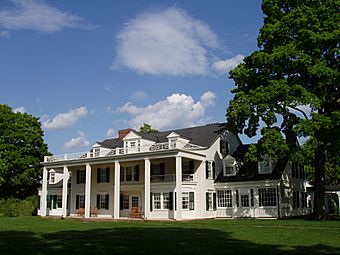Hill–Stead Museum facts for kids
|
Hill–Stead Museum
|
|
|
U.S. Historic district
Contributing property |
|

Hill–Stead Museum
|
|
| Lua error in Module:Location_map at line 420: attempt to index field 'wikibase' (a nil value). | |
| Location | 35 Mountain Road, Farmington, Connecticut |
|---|---|
| Area | 150 acres (0.61 km2) |
| Built | 1901 |
| Architect | Theodate Pope Riddle in association with McKim, Mead and White |
| Architectural style | Colonial Revival |
| Website | Hill–Stead Museum |
| Part of | Farmington Historic District (ID72001331) |
| NRHP reference No. | 91002056 |
Quick facts for kids Significant dates |
|
| Added to NRHP | July 17, 1991 |
| Designated NHL | July 17, 1991 |
| Designated CP | March 17, 1972 |
The Hill–Stead Museum is a special house and art museum located in Farmington, Connecticut. It's built in the Colonial Revival style, which means it looks like old colonial homes but was built more recently. The museum is famous for its amazing collection of French Impressionist paintings, its beautiful architecture, and its large, peaceful grounds.
This property is so important that it was named a National Historic Landmark. This means it's a nationally significant example of Colonial Revival architecture. The house was finished in 1901. It was designed through a special teamwork effort between Theodate Pope Riddle and the well-known architecture firm McKim, Mead & White. Theodate Pope Riddle was one of the first female architects in the United States. The house was built for her father, Alfred Atmore Pope, and both he and Theodate collected the art you can see there today.
Contents
A Special House and Museum
Hill–Stead started as a large country estate for a rich businessman named Alfred Atmore Pope. His daughter, Theodate Pope Riddle, designed the estate. An architect named Egerton Swartwout from the firm McKim, Mead, and White helped turn her ideas into building plans. Construction of the house took place from 1898 to 1901.
After her parents passed away, Theodate inherited the house. Before she died in 1946, she decided that Hill–Stead should become a museum. She wanted it to be a memorial to her parents and a place "for the benefit and enjoyment of the public." She made sure that the house and everything inside it would stay exactly as it was, never to be moved, borrowed, or sold.
Today, the Hill–Stead property covers about 152 acres (0.6 km2). Some parts of the original land were sold off when the museum first opened. The main building is the Pope-Riddle House, a very large mansion that is about 33,000-square-foot (3,100 m2). The famous writer Henry James, who sometimes visited, once called it "a great new house on a hilltop." Other buildings on the property include an old 18th-century farmhouse, a carriage garage with a theater, a barn, and other farm buildings.
Visitors can explore 19 rooms in the house. Everything is kept just as it was when Theodate died. The house is filled with beautiful paintings, prints, special objects, and fine furniture and rugs. Some of the most important artworks include paintings by famous artists like Mary Cassatt, Edgar Degas, Édouard Manet, Claude Monet, and James McNeill Whistler.
The museum also has prints, including three engravings by Albrecht Dürer and many etchings and lithographs by James McNeill Whistler. You can also see Japanese woodblock prints by artists like Katsushika Hokusai and Utagawa Hiroshige. There are eight bronze sculptures by Antoine-Louis Barye. The museum also keeps about 13,000 letters and postcards, including letters from Mary Cassatt and Henry James. Plus, there are about 2,500 photographs, some of which are art photos by Gertrude Käsebier.
Exploring the Gardens and Grounds
The outdoor areas of Hill–Stead were first planned with help from a landscape architect named Warren H. Manning. The grounds feature a wide lawn, an artificial pond, and a formal, eight-sided flower garden.
Around 1920, a landscape gardener named Beatrix Farrand redesigned the estate's Sunken Garden. This garden is about 1 acre in size. During World War II, there weren't enough workers, so the garden became covered in grass, with only a small summerhouse remaining. Even though it was replanted later, it wasn't until the 1980s that the Sunken Garden was fully restored to look like Beatrix Farrand's original design.
A National Historic Landmark
Hill–Stead was officially named a National Historic Landmark in 1991. This means it is recognized as a very important historical place in the United States. The museum is also home to one of the longest-running poetry festivals in the country, called the Sunken Garden Poetry Festival. This festival takes place in the beautiful Sunken Garden.
Gallery
See also
 In Spanish: Hill-Stead Museum para niños
In Spanish: Hill-Stead Museum para niños







